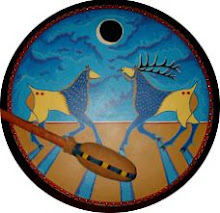
Dopo la colonizzazione l'abbigliamento dei Nativi americani cominciò a cambiare. Appena le tribù indiane furono cacciate dalle loro terre di appartenenza e costrette ad un più stretto contatto con altre tribù, ciascuna di esse iniziò a prendere reciprocamente in prestito gli abiti tribali delle altre, in tal modo frange, capi in pelle di daino, acconciature di piume, e coperte di lana diventarono popolari anche fuori dalle tribù in cui erano nati. D'altro canto, gli Indiani cominciarono ad adeguare alcuni capi di vestiario europeo al proprio stile, così capi in panno di lana furono decorati nello stile tipico dei Nativi americani. Questi vestiti non erano originari delle Americhe, ma dal 1800 sono diventati per chiunque li osserva il tipico abbigliamento indiano. Questi abiti post-coloniali comprendono giacche e camicie di perline, camicie decorate con nastri di seta, gonne e scialli di raso lavorati a patchwork fra i Seminole, maglioni di lana, applicazioni di nastri, abiti con pendenti in metallo, ed il famoso "Cherokee Tear dress". Oggi, la maggior parte dei Nativi americani indossano abiti contemporanei nella loro vita quotidiana, tuttavia l'abbigliamento tradizionale indiano esiste ancora. Alcuni abiti tradizionali, come quelli in pelle, in tessuto con nastri o i mocassini decorati, sono ancora usati in molte tribù, particolarmente per eventi formali. Altri, come il breechcloth, i gambali, i copricapi e gli scialli da ballo, sono indossati soltanto nei Powwows o in cerimonie religiose. In generale, gli Indiani americani usano la parola "Regalia"per l'abbigliamento tradizionale che viene utilizzato per le cerimonie.
---------------------------------------
After colonization, Native American clothes began to change. For one thing, as Indian tribes were driven from their ancient lands and forced into closer contact with each other, they began to borrow some of each other's tribal dress, so that fringed buckskin clothing, feather headdresses, and woven blankets became popular among Indians outside of the tribes in which they originated. For another, Indians began to adapt some articles of European costume to their own style, decorating cloth garments with characteristic Native American beadwork, embroidery, and designs. These clothes were not original to the Americas, but by the 1800's they were recognized by anyone viewing them as Indian apparel. Such post-colonial native dress includes beaded jackets and shirts, ribbon shirts, Seminole patchwork skirts, satin shawls, woolen sweaters, broad ribbon applique, jingle dresses, and the Cherokee tear dress. Today, most Native Americans wear contemporary American and Canadian clothes in their daily life; however, unique American Indian clothing styles still exist. Some traditional Indian garments, such as buckskins, ribbon dresses, and beaded moccasins, are still worn in many tribes, particularly to formal events. Others, such as breechcloth, leggings, headdress and dance shawl, are only worn at powwows and religious ceremonies. In general, American Indians use the word "regalia" for traditional clothing which is used for ceremonial occasions.
Una giacca da me realizzata











